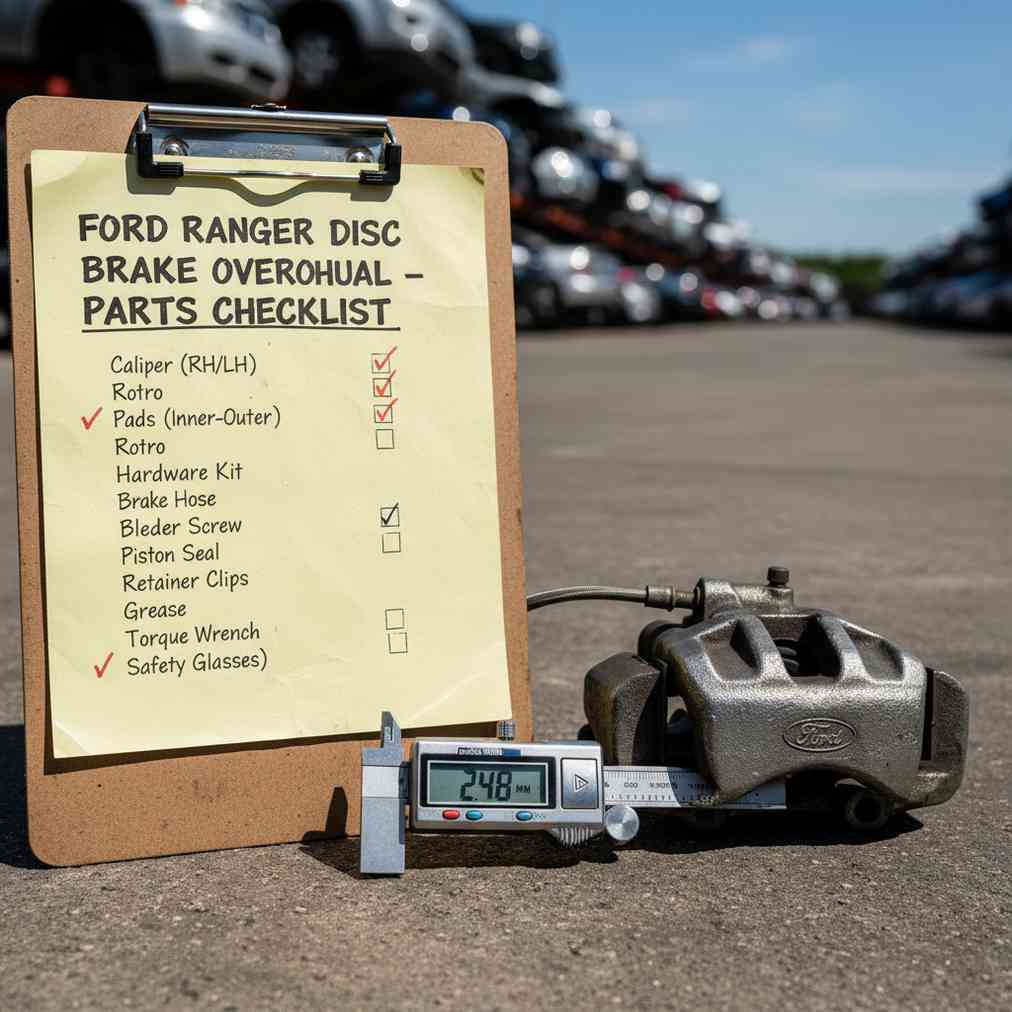Understanding Self-Service Yards and Why Preparation Matters
Self-service auto yards have revolutionized the way car enthusiasts and budget-conscious vehicle owners acquire replacement parts. Unlike traditional auto parts stores, these facilities allow customers to remove parts themselves from salvaged vehicles, offering significant savings and the opportunity to inspect parts before purchase. However, success in these environments depends heavily on thorough preparation, particularly creating a comprehensive inventory checklist before your visit.
The difference between a productive yard visit and a frustrating waste of time often comes down to preparation and organization. A well-crafted inventory checklist transforms what could be an overwhelming search through hundreds of vehicles into a targeted, efficient mission that saves both time and money.
The Strategic Advantages of Using Used Auto Parts
Before diving into checklist creation, it’s essential to understand why self-service yards and used parts represent such valuable resources for vehicle maintenance and repair.
Financial Benefits That Make a Real Difference
Cost savings remain the primary driver for most customers visiting self-service yards. Used parts typically cost 50-70% less than new OEM components, with some specialized or rare parts offering even greater savings. This price advantage becomes particularly significant for older vehicles where new part costs might exceed the vehicle’s value.
- Immediate availability: Parts are accessible on-site without waiting for shipping or special orders
- Environmental responsibility: Reusing components reduces waste and manufacturing demand
- Original equipment quality: Many used parts are genuine OEM components rather than aftermarket alternatives
- Hands-on inspection: Direct examination allows quality assessment before purchase
Availability for Rare and Discontinued Parts
Self-service yards serve as treasure troves for owners of older or rare vehicles. When manufacturers discontinue production of specific components, salvage yards near you often become the only reliable source for authentic replacement parts. This availability extends the practical lifespan of older vehicles that might otherwise become unrepairable due to parts scarcity.
Pre-Visit Planning: Setting Yourself Up for Success
Effective self-service yard visits begin long before you arrive at the facility. Modern yards increasingly offer online inventory systems that allow customers to verify vehicle availability and plan their visits strategically.
Essential Research Steps
| Research Category | Specific Actions | Why It Matters |
|---|---|---|
| Inventory Verification | Check yard websites or call to confirm donor vehicles | Eliminates wasted trips and identifies multiple part sources |
| Part Specifications | Record VIN, part numbers, and exact measurements | Ensures compatibility and prevents incorrect part selection |
| Yard Policies | Review hours, fees, warranty terms, and tool restrictions | Avoids surprises and ensures compliance with facility rules |
| Tool Requirements | Identify specific tools needed for target parts | Prevents inability to remove desired components |
Understanding Yard Operations and Policies
Each self-service facility operates under specific rules and procedures. Familiarizing yourself with these policies prevents complications and ensures a smooth experience. Most yards require customers to bring their own tools, impose time limits on vehicle access, and maintain specific safety requirements.
- Operating hours: Plan visits during optimal times when lighting and staff availability support efficient parts removal
- Entry fees and pricing: Understand cost structures to budget appropriately for your visit
- Return policies: Know warranty terms and exchange options before making purchases
- Safety requirements: Comply with protective equipment and proper footwear mandates
Creating Your Comprehensive Inventory Checklist
A well-structured inventory checklist serves multiple purposes: it organizes your search, ensures you don’t forget critical items, and provides a systematic approach to part evaluation. The most effective checklists incorporate both preparation elements and on-site assessment criteria.
Essential Pre-Visit Information to Document
Your checklist should begin with fundamental vehicle and part information that ensures compatibility and guides your search efforts. This foundation prevents the common mistake of removing parts that won’t fit your specific vehicle configuration.
- Vehicle specifications: Year, make, model, engine type, and transmission details
- VIN numbers: Both your vehicle and target donor vehicles when possible
- Part numbers: Manufacturer part numbers for precise identification
- Critical measurements: Dimensions, thread sizes, bolt patterns, and mounting specifications
- Quantity requirements: Number of each part needed and any related components
Organizing Your Checklist by Vehicle Systems
Systematic organization improves efficiency and reduces the likelihood of overlooking important components. Grouping parts by vehicle systems also helps identify opportunities to source multiple related components from the same donor vehicle.
| System Category | Common Parts | Inspection Priorities |
|---|---|---|
| Engine Components | Alternators, starters, water pumps, intake manifolds | Mounting condition, electrical connections, fluid leaks |
| Suspension & Steering | Control arms, struts, tie rods, steering wheels | Bushing wear, joint condition, alignment of components |
| Braking System | Calipers, rotors, brake boosters, ABS modules | Pad thickness, rotor condition, hydraulic leaks |
| Body & Interior | Doors, fenders, seats, dashboard components | Damage assessment, color matching, mounting points |
| Electrical Systems | ECUs, wiring harnesses, switches, sensors | Connector integrity, wire condition, corrosion signs |
Detailed Part Inspection Procedures
The quality of used parts varies significantly, making thorough inspection crucial for successful purchases. Your checklist should include specific evaluation criteria for different component types, ensuring you can quickly assess part condition and remaining useful life.
Mechanical Component Assessment
Mechanical parts require careful examination of wear patterns, structural integrity, and functional condition. Visual inspection combined with hands-on testing provides the most reliable assessment of part viability.
- Surface condition: Look for cracks, excessive wear, or corrosion that could affect performance
- Mounting points: Examine bolt holes, brackets, and attachment surfaces for damage
- Moving parts: Test rotation, articulation, and smooth operation where possible
- Seal integrity: Check gaskets, O-rings, and sealing surfaces for damage or deterioration
- Thread condition: Verify that bolt threads are clean and undamaged
Electrical Component Evaluation
Electrical components present unique challenges in used parts evaluation, as internal damage may not be immediately visible. Focus on external indicators and connection quality when assessing electrical parts.
“Electrical connectors and wiring harnesses often reveal the overall care and maintenance history of a vehicle. Clean, corrosion-free connections typically indicate better part reliability.”
Body and Exterior Part Considerations
Body components require assessment beyond basic functionality, including cosmetic condition, paint matching, and structural integrity. These parts often need additional finishing work, which should factor into your purchase decision.
Tool Preparation and Safety Considerations
Self-service yards require customers to provide their own removal tools, making proper preparation essential for successful parts extraction. Your tool list should cover basic removal needs while including specialized items for specific components.
Essential Tool Categories
| Tool Category | Specific Items | Primary Uses |
|---|---|---|
| Basic Hand Tools | Socket sets, wrenches, screwdrivers, pliers | General bolts, screws, and fastener removal |
| Specialty Tools | Torx bits, spline keys, pullers, pry bars | Specific fasteners and component separation |
| Cutting Tools | Wire cutters, tin snips, reciprocating saw blades | Wiring, straps, and stubborn component removal |
| Safety Equipment | Gloves, safety glasses, steel-toe boots | Personal protection during parts removal |
| Assistance Items | Penetrating oil, rags, flashlight, magnetic tray | Ease removal and organize small parts |
Safety Protocol Integration
Safety considerations should be woven throughout your checklist, not treated as an afterthought. Self-service yards present various hazards, from sharp metal edges to unstable vehicle positioning, requiring constant awareness and proper protective equipment.
- Personal protective equipment: Always wear safety glasses, work gloves, and appropriate footwear
- Vehicle stability: Ensure vehicles are properly supported before working underneath
- Environmental awareness: Watch for fluid spills, broken glass, and other hazards
- Tool safety: Use tools properly and maintain awareness of cutting edges and pinch points
Digital Tools and Modern Checklist Solutions
Modern technology offers several advantages for creating and managing inventory checklists. Digital solutions provide flexibility, real-time updates, and integration with measurement tools and cameras for comprehensive documentation.
Recommended Digital Platforms
Several online platforms offer customizable inventory templates that can be adapted for self-service yard visits. Smartsheet’s inventory templates provide professional organization tools, while Plaky’s inventory templates offer user-friendly interfaces for detailed record-keeping.
For users seeking comprehensive inventory management solutions, specialized inventory management templates provide advanced features for tracking multiple projects and vendor sources. These platforms typically offer both digital and printable formats, accommodating different working styles and yard environments.
Mobile Applications and Offline Capabilities
Smartphone applications can enhance your yard experience by providing measurement tools, part identification assistance, and offline checklist access. However, many yards have limited cellular service, making offline capability essential for reliable checklist access.
- Measurement apps: Digital calipers and rulers for precise part sizing
- Part identification: Visual search tools for unknown components
- Note-taking: Voice recordings and photo documentation for complex parts
- Offline maps: Yard layout navigation and vehicle location tracking
Creating Printable Checklist Templates
Despite digital advancement, printable checklists remain valuable for yard environments where electronic devices may be impractical or vulnerable to damage. Well-designed PDF inventory sheet templates provide durability and ease of use in challenging conditions.
Template Design Considerations
Effective printable templates balance comprehensive information capture with practical usability. Templates should include adequate space for handwritten notes while maintaining clear organization and logical flow.
Free inventory templates are available from various sources, though customization for automotive applications typically requires modification. Creating custom inventory spreadsheets allows precise tailoring to your specific needs and working style.
Advanced Strategies for Experienced Yard Visitors
Experienced self-service yard visitors often develop sophisticated strategies that go beyond basic checklists. These advanced techniques maximize efficiency and improve success rates through strategic planning and relationship building.
Multi-Visit Planning and Inventory Tracking
Professional mechanics and frequent visitors often maintain detailed databases of yard inventory, tracking vehicle arrivals and part availability over time. This approach enables strategic timing of visits and increases the likelihood of finding rare or high-demand components.
- Seasonal planning: Time visits to coincide with fresh inventory arrivals
- Network building: Develop relationships with yard staff for inventory insights
- Bulk purchasing: Identify opportunities to acquire multiple parts during single visits
- Quality assessment: Develop experience-based shortcuts for rapid part evaluation
Integration with Professional Templates
Professional-grade inventory solutions like Microsoft’s inventory templates and Canva’s inventory designs can be adapted for sophisticated yard operations. These platforms offer advanced features like barcode integration, automated calculations, and professional formatting options.
Economic Impact and Cost-Benefit Analysis
Understanding the financial implications of self-service yard visits helps justify the time investment in thorough preparation. Proper planning can significantly improve your return on investment while reducing the total cost of vehicle maintenance.
Quantifying Time and Cost Savings
Industry data suggests that well-prepared yard visits can save 30-40% of the time typically required for parts acquisition while achieving cost savings of 50% or more compared to new parts. These savings become particularly significant for expensive components like transmissions, engines, and electronic control modules.
| Cost Category | New Parts | Used Parts | Potential Savings |
|---|---|---|---|
| Engine Components | $200-2000+ | $50-600 | 60-75% |
| Transmission Parts | $1500-4000+ | $300-1200 | 70-80% |
| Body Components | $300-1500 | $75-400 | 65-75% |
| Electrical Systems | $100-800 | $25-200 | 70-75% |
Common Mistakes and How to Avoid Them
Even experienced yard visitors occasionally make costly mistakes that could be prevented through better preparation and systematic approaches. Understanding these common pitfalls helps improve your success rate and reduces frustration.
Preparation-Related Errors
The most expensive mistakes typically occur before arriving at the yard, involving inadequate research or incorrect part identification. These errors can result in wasted trips, incompatible parts, or missed opportunities for better alternatives.
- Insufficient research: Failing to verify part compatibility or donor vehicle availability
- Inadequate tools: Arriving without proper removal equipment for target components
- Poor timing: Visiting during peak hours or weather conditions that limit effectiveness
- Incomplete documentation: Forgetting measurements, part numbers, or vehicle specifications
On-Site Assessment Mistakes
Rushed part evaluation often leads to purchasing components that fail prematurely or require additional work. Taking time for thorough inspection prevents these costly oversights and ensures better long-term satisfaction.
“The few extra minutes spent thoroughly inspecting a used part can save hours of reinstallation work and additional parts costs down the road.”
Future Trends in Self-Service Yard Operations
The self-service auto parts industry continues evolving, incorporating new technologies and customer service improvements that enhance the yard experience. Understanding these trends helps prepare for future developments and potential improvements in inventory management.
Technology Integration
Modern yards increasingly adopt digital solutions for inventory management, customer service, and operational efficiency. These improvements benefit customers through better part availability information and enhanced facility navigation.
- RFID tracking: Real-time inventory updates and precise part location information
- Mobile applications: Enhanced customer apps with augmented reality features
- Online reservations: Ability to reserve specific vehicles or parts for future visits
- Digital payment systems: Streamlined checkout processes and electronic receipts
Building Your Personal Yard Success System
Developing a personal system for self-service yard success requires combining the strategies and tools discussed into a cohesive approach that matches your specific needs and working style. The most effective systems evolve over time, incorporating lessons learned and adapting to changing requirements.
Whether you need cash for cars from selling your old vehicle or want to maintain your current car affordably, self-service yards represent valuable resources when approached systematically. The investment in proper preparation and checklist development pays dividends through improved success rates, reduced costs, and more efficient use of your time.
Success in self-service yards ultimately depends on preparation, systematic approach, and continuous learning. By creating comprehensive inventory checklists, understanding part evaluation procedures, and maintaining proper tools and safety equipment, you can consistently achieve excellent results while enjoying significant cost savings on vehicle maintenance and repair projects.





Leave a Reply
You must be logged in to post a comment.